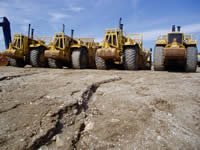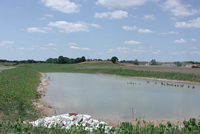Erosion control and storm water management plans
before mobilizing equipment.
Photo by Bryan Hartsook
- When are plans developed?
- Erosion control plans
- Inspection requirements
- Storm water management plans
- Long-term maintenance for storm water stuctures
- Erosion control and storm water management plans review
- Technical standards for erosion control and storm water management
- Additional information
- Additional links
The landowner has the responsibility to oversee the development of a site-specific erosion control and storm water management plan and the installation, maintenance, and inspection of all Best Management Practices (BMPs). These BMPs include structural and non-structural measures, practices, techniques or devices used to avoid or minimize soil, sediment or pollutants carried in runoff to waters of the state.
When to develop plans?
Erosion control and stormwater plans must be developed and completed before the landowner files a WRAPP (equivalent to the NOI) at least 14 working days before construction begins. Because every site is unique, erosion control and storm water management plans must be customized to site-specific conditions. The plans must meet the construction and post-construction performance standards and the format identified in Ch. NR 216, Wis. Adm. Code [Exit DNR], as well as local municipal ordinances and regulations.
Erosion control plans
The erosion control plan for a construction site, in accordance with s. NR 216.46, Wis. Adm. Code, addresses the discharge of sediment and other pollutants that are carried in runoff from the construction site. The plan details how to control sediment and other pollutants on the construction site by using control practices throughout the duration of the construction project and stabilization of the site. Erosion and sediment control Best Management Practices (BMPs) include sediment ponds, tracking pads, silt fences and temporary seeding. Sequencing, inspection and maintenance procedures for BMPs must be included in the erosion control plan.
A common misconception is that the erosion control plan is the same as engineering plans or drawings. The erosion control plan is primarily a narrative document with some mapping requirements presented in the format identified in s. NR 216.46(4) to (8), Wis Adm.Code, and is supported by engineered plans and calculations. The DNR, with the help of technical experts, has developed several erosion and sediment control technical standards to assist landowners and contractors in developing a construction site erosion control plan.
Erosion and sediment control basic principles
during construction.
Photo by Bryan Hartsook
- Minimize open area by phasing or sequencing construction and preserving existing vegetation where possible.
- Divert storm water away from disturbed or exposed areas when possible.
- Install BMPs to control erosion and sediment and manage storm water.
- Inspect the site regularly and properly maintain BMPs, especially after rainstorms.
- Revise the plan as site conditions change during construction and improve the plans if BMPs are not effectively controlling erosion and sediment.
- Keep the construction site clean by putting trash in trash cans, keeping storage bins covered, and preventing or removing excess sediment on roads and other impervious surfaces.
Inspection requirements
Inspections of construction BMPs are required at least once every seven days and within 24 hours after a precipitation event of 0.5 inch or more. The Construction Site Inspection Report Form may be used to document inspections. Best Management Practices must be repaired or replaced within 24 hours of inspection or notification of a problem. Under s. 216.48(4), Wis Stats., remember to keep records of maintenance activities and any plan modifications at the construction site, available for review during a DNR inspection.
Storm water management plans
The storm water management plan should include a description of management practices that will be installed during the construction phase to address the discharge of total suspended solids, control peak flow, provide for infiltration, and maintain protective areas from the post-construction site.
In addition, the plan must comply with s. NR 216.47 and the applicable post-construction performance standards in ch. NR 151, Wis. Adm. Code.
| Post-construction storm water management involves having BMPs designed, installed, and maintained to meet NR 151 performance standards in four areas: | |
|---|---|
| 1. Water quality | Reduce total suspended solids (TSS) carried in runoff from the site. |
| 2. Water quantity | Maintain peak runoff rates to the pre-development conditions. |
| 3. Infiltration | Infiltrate a sufficient amount of runoff volume from the post-developed site as compared to pre-development conditions. |
| 4. Protective areas for lakes, streams and rivers, and wetlands* | Maintain a vegetated area to serve as a transitional zone between urban development and water resources that will both filter pollutants and reduce flow velocity. |
* Note: See guidance for wetland protective areas.
The plan may include BMPs such as wet ponds, infiltration structures, grass swales, vegetative filter strips and biofilters to control runoff from the site after construction is completed.
Long-term maintenance for storm water stuctures
The landowner is required to develop and finalize a long-term maintenance agreement for permanent storm water management structures prior to submitting the WRAPP to the DNR. The agreement identifies the person(s) responsible for long-term maintenance of the storm water treatment devices that remain on the site after the construction phase is completed.
Sediment removal from wet and dry detention ponds and infiltration basins may be subject to the requirements of ch. NR 528, Accumulated Sediment from Storm Water Management Ponds. Chapter NR 528 requires sediment managers use a certification form [PDF] to guide and record their evaluation of accumulated sediment. See more information at A guide for sediment managers and environmental professionals [PDF]. See also "Whose pond is it anyway?" for more information on maintaining stormwater ponds.
Erosion control and storm water management plans review
- Department staff may request submittal of the plans for review prior to permit issuance and may withhold automatic permit coverage to review erosion control and storm water management plans.
- The plans must be available on-site for review during an inspection.
- The landowner must update the plans as needed to accommodate changes in construction sequencing or site modifications to increase the effectiveness in controlling pollutants and runoff.
Technical standards for erosion control and storm water management
The DNR maintains a list of erosion control and storm water management technical standards. The technical standards were developed to assist landowners and contractors in developing their plans.
The Department of Transportation maintains a list of approved products for erosion and sediment control called the Product Acceptability List (PAL) [Exit DNR]. In the technical standards, the criteria references the PAL for manufactured products such as straw wattles, soil stabilizers, and inlet protection.
Check with your local municipality for additional design specifications and standards that may be contained in local ordinances.
Additional information
These publications are available for download at the UW-Extension Publications Learning Store [exit DNR]:
- Erosion Control for Home Builders [PDF 301KB, Exit DNR]
- Stormwater Basins - using natural landscaping for water quality & esthetics [Exit DNR]
- Storm Water Detention Ponds Site Safety & Design [Exit DNR]


